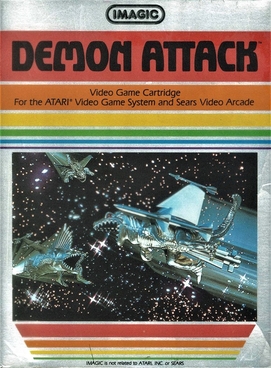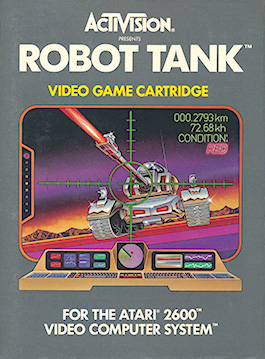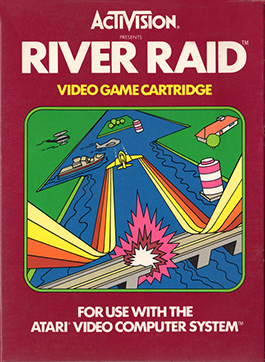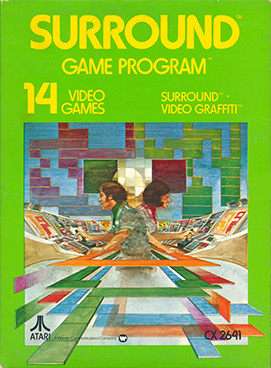
Star Raiders is a space combat simulator video game created by Doug Neubauer and published in 1980 by Atari, Inc. Originally released for the Atari 400/800 computers, Star Raiders was later ported to the Atari 2600, Atari 5200, and Atari ST. The player assumes the role of a starship fighter pilot, who must protect starbases from invading forces called Zylons. Piloting and combat are shown in the 3D cockpit view, while a 2D galactic map shows the state of the Zylon invasion. Neubauer made the game during in his spare time at Atari, inspired by contemporary media such as Battlestar Galactica and Star Wars, as well as the 1971 mainframe game Star Trek.

Pitfall! is a video game developed by David Crane for the Atari 2600 and released in 1982 by Activision. The player controls Pitfall Harry, who has a time limit of 20 minutes to seek treasure in a jungle. The game world is populated by enemies and hazards that variously cause the player to lose lives or points.

Phoenix is a fixed shooter video game developed for arcades in Japan and released in 1980 by Taito. The player controls a space ship shooting at incoming enemies that fly from the top of the screen down towards the player's ship. There are five stages which repeat endlessly. The fifth is a fight against a large enemy spaceship, making Phoenix one of the first shooters with a boss battle, an element that would become common for the genre.

Combat is a 1977 video game by Atari, Inc. for the Atari Video Computer System. In the game, two players controlling either a tank, a biplane, or a jet fire missiles at each other for two minutes and sixteen seconds. Points are scored by hitting the opponent, and the player with the most points when the time runs out wins. Variations on the gameplay introduce elements such as invisible vehicles, missiles that ricochet off of walls, and different playing fields.

Demon Attack is a fixed shooter video game created by Rob Fulop for the Atari 2600 and published by Imagic in 1982. The game involves the player controlling a laser cannon from the surface of a planet, shooting winged demons that fly down and attack the player in different sets of patterns.

David Crane is an American video game designer and programmer. Crane grew up fascinated by technology and went to DeVry Institute of Technology. Following college, he went to Silicon Valley and got his first job at National Semiconductor. Through his friend Alan Miller he learned about potential video game design work at Atari, Inc. and began work there in 1977.

Robot Tank is a first-person shoot 'em up written by Alan Miller for the Atari 2600 and published by Activision in 1983. It is similar in design to Atari, Inc.'s Battlezone tank combat arcade video game and more so to its 2600 port. Robot Tank adds different systems which can individually be damaged—instead of the vehicle always exploding upon being shot—and weather effects.

Keystone Kapers is a platform game developed by Garry Kitchen for the Atari 2600 and published by Activision in 1983. The game involves a Keystone Cops-theme, with the player controlling police officer Kelly, who traverses the many levels of a department store, dodging objects to catch the escaped thief Harry Hooligan.

Haunted House is a 1982 adventure video game programmed by James Andreasen for the Atari Video Computer System and published by Atari. The player controls an avatar shaped like a pair of eyes who explores a mansion seeking out parts of an urn to return to the entrance. The game world is populated by roaming enemies including vampire bats, tarantulas, and a ghost. Haunted House was among the first games to use player-controlled scrolling between large portions of the visual space.

River Raid is a video game developed by Carol Shaw for the Atari Video Computer System and released in 1982 by Activision. The player controls a fighter jet over the River of No Return in a raid behind enemy lines. The goal is to navigate the flight by destroying enemy tankers, helicopters, fuel depots and bridges without running out of fuel or crashing.

Pitfall II: Lost Caverns is a video game developed by David Crane for the Atari 2600. It was released in 1984 by Activision. The player controls Pitfall Harry, who must explore in wilds of Peru to find the Raj Diamond, and rescue his niece Rhonda and their animal friend Quickclaw. The game world is populated by enemies and hazards that variously cause the player to lose points and return to a checkpoint.

Air-Sea Battle is a fixed shooter developed and published by Atari, Inc. for the Atari VCS. Air-Sea Battle is partially based on the 1975 Atari arcade video game Anti-Aircraft where each player uses a ground-based gun to shoot passing aircraft. The cartridge adds other variants, such as planes dropping bombs on ships and a carnival-themed shooting gallery.
In the history of video games, the second-generation era refers to computer and video games, video game consoles, and handheld video game consoles available from 1976 to 1992. Notable platforms of the second generation include the Fairchild Channel F, Atari 2600, Intellivision, Odyssey 2, and ColecoVision. The generation began in November 1976 with the release of the Fairchild Channel F. This was followed by the Atari 2600 in 1977, Magnavox Odyssey² in 1978, Intellivision in 1980 and then the Emerson Arcadia 2001, ColecoVision, Atari 5200, and Vectrex, all in 1982. By the end of the era, there were over 15 different consoles. It coincided with, and was partly fuelled by, the golden age of arcade video games. This peak era of popularity and innovation for the medium resulted in many games for second generation home consoles being ports of arcade games. Space Invaders, the first "killer app" arcade game to be ported, was released in 1980 for the Atari 2600, though earlier Atari-published arcade games were ported to the 2600 previously. Coleco packaged Nintendo's Donkey Kong with the ColecoVision when it was released in August 1982.

Megamania is a fixed shooter video game developed by Steve Cartwright for the Atari 2600. It was published by Activision in 1982. A pilot of an intergalactic space cruiser has a nightmare where his ship is being attacked by food and household objects. Using the missile launcher from their space cruiser, the pilot fends of the attackers. The game was later released for the Atari 5200 and Atari 8-bit computers.

Enduro is a racing video game designed by Larry Miller for the Atari 2600 and published by Activision in 1983. The object of the game is to complete an endurance race, passing a certain number of cars each day to continue the next day. The visuals change from day to night, and there is occasional inclement weather.

Star Wars: The Empire Strikes Back is a scrolling shooter video game programmed by Rex Bradford for the Atari 2600 and published by Parker Brothers in 1982. It was the first licensed Star Wars video game. An Intellivision version was released in 1983.

Superman is a video game programmed by John Dunn for the Atari Video Computer System and released in 1979 by Atari, Inc. The player controls Superman, whose quest is to explore an open-ended environment to find three pieces of a bridge that was destroyed by Lex Luthor, capture Luthor and his criminal gang, and return to the Daily Planet building. The game world is populated by antagonists such as a helicopter that re-arranges the bridge pieces and roving kryptonite satellites that cause Superman to revert into Clark Kent.

Surround is a video game programmed by Alan Miller and published by Atari, Inc. for the Atari Video Computer System. The game plays similarly to the arcade game Blockade (1976), which allows players to navigate a continuously moving block around an enclosed space as a wall trails behind it. Every time the opposite player has their brick hit a wall, the opposing player earns a single point, with the winner being the first to collect ten points.

Street Racer is a racing video game developed for the Atari Video Computer System, later known as the Atari 2600. It was programmed by Larry Kaplan and released by Atari, Inc. in September 1977 as one of the nine Atari VCS launch titles. The game was also published by Sears for their Tele-Games product line as Speedway II.

RealSports Baseball is a 1982 sports video game developed and published by Atari, Inc. originally for the Atari 2600. It was also launched on the Atari 5200 and 7800 machines. A version for the Atari 8-bit computers was in development, but cancelled.






















